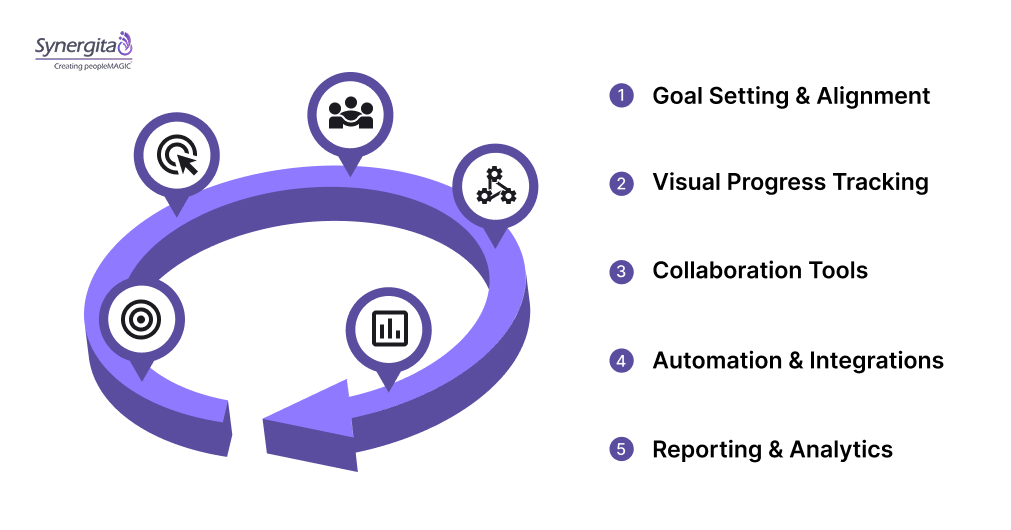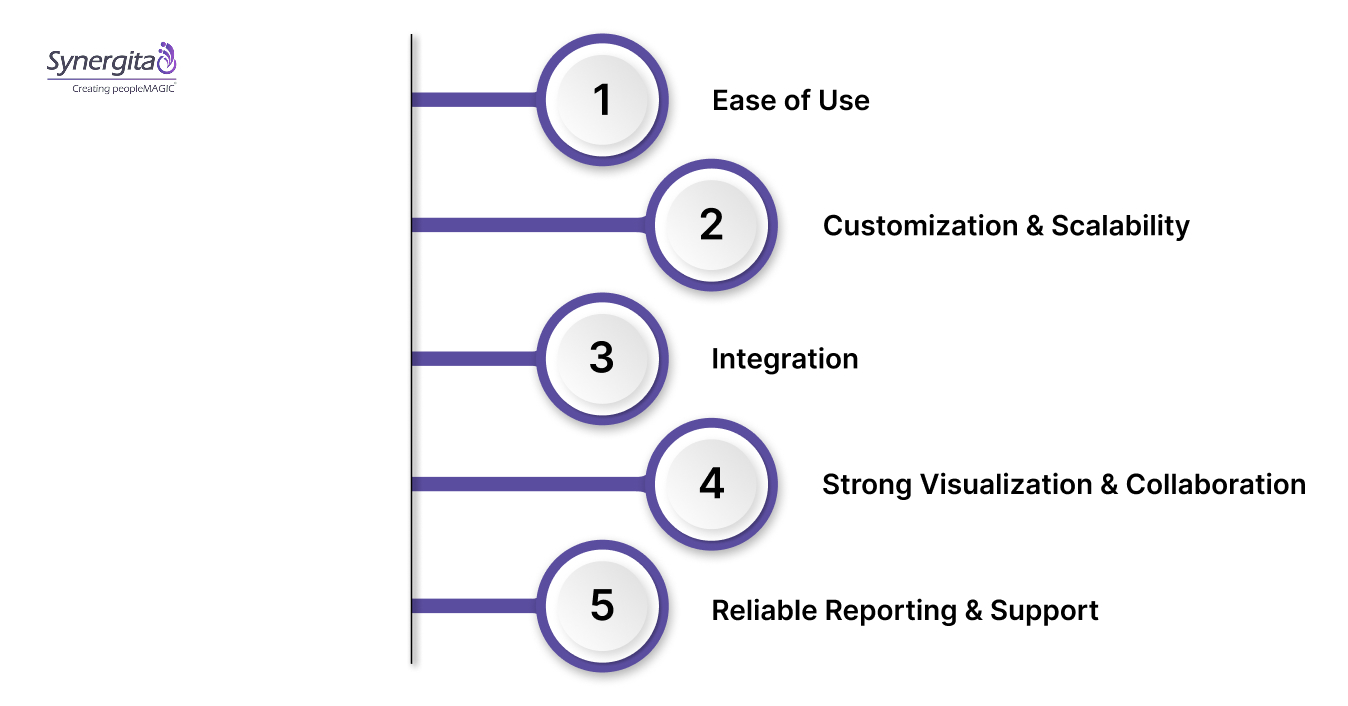By 2025, nearly half of Fortune 500 companies will be powered by OKRs, with 70% of large businesses placing them at the core of their strategy. But when OKRs stretch across multiple departments, chaos can quickly take over—missed updates, confusion, and stalled progress become all too common.
The key to winning with OKRs? Utilizing advanced tools for visualizing management OKR progress across multiple departments provides crystal-clear visibility and alignment with your goals.
In this blog, you’ll discover the best OKR software platforms designed to streamline tracking and supercharge collaboration with powerful dashboards and vivid visual goal views—so your teams stay focused, aligned, and unstoppable.
Key Takeaways
- OKRs are becoming essential for many organizations, but managing them across different departments can quickly become complicated without the right tools.
- The key to success is utilizing powerful tools that visualize OKR progress across departments, providing clear visibility and alignment.
- The best OKR software offers easy goal-setting, real-time progress tracking, seamless collaboration, and smart integrations with apps like Jira and Microsoft Teams.
- When choosing OKR tools, focus on ease of use, scalability, customization, integration, and firm support.
- Synergita stands out with its intuitive dashboards, AI-powered assistance, and seamless integrations—helping your teams turn goals into measurable results effortlessly.
What Is OKR Software?
OKR software is a digital tool that helps your business set, track, and manage goals at all levels—whether for individuals, teams, or the whole company. It provides dashboards, progress updates, and reports so everyone can see how well the company is doing against its key priorities.
Why OKR Software Matters: Features and Benefits

OKR software comes with key features that make managing goals easier and more effective.
- Goal Setting & Alignment: Create and link objectives across departments to keep everyone moving in the same direction, boosting overall alignment.
- Visual Progress Tracking: Use dashboards, heatmaps, and real-time charts to see progress clearly and spot any roadblocks early.
- Collaboration Tools: Keep communication flowing with task linking, @mentions, and comments, breaking down silos across teams.
- Automation & Integrations: Sync with business apps like Jira, Slack, and Microsoft Teams to automate updates and reduce manual work.
- Reporting & Analytics: Access advanced reports and data insights that help your team measure success and make smarter decisions quickly.
Together, these features improve transparency, ensure more substantial alignment, boost accountability, speed up decision-making, and encourage better collaboration across your organization.
Top OKR Software Tools That You Must Consider
As OKRs become standard practice in fast-growing companies, finding the right software isn’t just about ticking boxes—it’s about choosing a tool that actually helps your startup scale without losing alignment. Here are the top platforms worth your attention in 2025, with a deeper look into what they offer, how they help startups, and where you may need to compromise.
1. Synergita
Synergita offers an easy-to-use platform for tracking and cascading goals across teams with real-time collaboration.
Startups often grow faster than their internal systems can handle, and that’s where Synergita shines. It’s designed not just for tracking OKRs but also for ensuring that goals cascade smoothly across teams. Think of it as the visual “nervous system” of your startup, keeping leadership and teams connected to the same priorities.
- Goal-setting: Synergita’s dashboards let HRs and managers set and cascade goals seamlessly, ensuring no department is working in isolation.
- Visual tracking: Its real-time heatmaps and dashboards give founders and team leads instant visibility into progress, bottlenecks, and at-risk goals.
- Collaboration: Features like task linking and @mentions keep the conversation inside the platform, reducing reliance on endless update meetings.
- Automation: With integrations into Jira and Microsoft Teams, Synergita reduces manual reporting, so teams can focus on execution rather than chasing updates.
2. Profit.co
Profit.co is a go-to platform for startups that need structure around OKRs but also want the flexibility to scale. It offers a mix of ready-to-use templates and customization options, which makes it easier for young teams to adopt OKRs without getting lost in complexity.
- Why startups love it: The platform helps even first-time OKR users design meaningful goals with guided templates, while managers can adapt dashboards to different teams.
- Standout feature: Its heatmaps and progress trackers give a quick “health check” of how teams are doing, making it simple for founders to course-correct.
- Collaboration & integration: With Jira, Slack, and Microsoft Teams integration, Profit.co sits comfortably in your existing workflow.
3. Perdoo
With high-end reporting anchored in its OKR and strategy management system, Perdoo helps your teams align. Perdoo is built for startups that want to tie OKRs directly to their broader company strategy. It’s not just about tracking tasks; it’s about seeing how every department’s efforts contribute to big-picture objectives.
- Why it works for startups: Startups often pivot, and Perdoo’s strategy maps make it easy to adjust OKRs while still showing how changes fit into the company’s mission.
- Analytics strength: Advanced KPI boards and progress views help leadership teams move beyond gut feeling and base decisions on real data.
- Collaboration angle: Features like feedback loops and 1:1s help HR leaders link OKRs with employee growth and performance conversations.
4. Microsoft Viva Goals
If your startup already runs on Microsoft 365, Viva Goals is a natural extension. It’s heavily AI-powered, helping teams set meaningful goals and sync them directly with existing Microsoft apps.
- Why startups use it: No need to add yet another tool to your stack—it blends right into Teams, Outlook, and the rest of your Microsoft suite.
- Visual clarity: Its interactive dashboards make it easy for founders and HRs to check progress without chasing updates.
- Automation: AI-assisted recommendations and automated reporting free up bandwidth for fast-moving teams.
5. ClickUp
ClickUp is more than an OKR tool—it’s an all-in-one project management hub. For startups wearing multiple hats, that versatility can be a lifesaver. You can set OKRs, track tasks, manage sprints, and handle collaboration in one place.
- Why it fits startups: It allows you to connect daily tasks directly to higher-level goals, so execution and strategy don’t drift apart.
- Visual side: Centralized tracking shows progress across teams, avoiding silos.
- Collaboration strength: Because ClickUp is also a task/project tool, conversations naturally stay tied to workstreams.
6. 15Five
15Five combines OKRs with performance management, making it a favorite for HR leaders who care about both goal tracking and employee engagement. It doesn’t just measure what gets done—it measures how people feel while doing it.
- HR advantage: Transparent dashboards show progress, while built-in check-ins and coaching tools help nurture a performance culture.
- Employee-first: Gamification and feedback loops give employees ownership of their goals, which can be motivating in high-pressure startup environments.
7. Omni HR
Lattice is designed for startups transitioning into scale-ups, with strong OKR alignment and continuous feedback features. It’s not just about goals—it’s about building a performance-driven culture.
- Culture builder: Encourages 1:1s, performance reviews, and ongoing feedback that align with OKRs.
- AI-powered boost: Uses predictive insights to guide productivity and alignment.
8. Lattice
Lattice integrates OKRs with AI-powered productivity and feedback tools to boost team alignment. Lattice is designed for startups transitioning into scale-ups, with strong OKR alignment and continuous feedback features. It’s not just about goals—it’s about building a performance-driven culture.
- Culture builder: Encourages 1:1s, performance reviews, and ongoing feedback that align with OKRs.
- AI-powered boost: Uses predictive insights to guide productivity and alignment.
9. Mooncamp
Transparent tracking, advanced filters, and Microsoft Teams collaboration make Mooncamp a strong choice for managing OKRs. Mooncamp prioritizes transparency and cross-team visibility. Its filters and direct editing features make it easy for startups to see exactly where they stand.
- Team-friendly: It promotes openness—everyone sees the same goals and updates.
- Integration strength: Works smoothly with Microsoft Teams for collaboration.
10. Quantive
Quantive provides scalable OKR management with customizable levels and advanced analytics. Quantive (formerly Gtmhub) is a data-heavy OKR platform that suits startups looking to scale with advanced analytics.
- Data advantage: Automated reporting and analytics help startups measure impact with precision.
- Scalability: Customizable OKR levels grow with your organization.
11. PatPat360
With easy-to-use dashboards, PatPat360 supports bottom-up goal setting and ongoing feedback. PatPat360 takes a unique bottom-up approach, giving employees a strong voice in setting OKRs. This is especially valuable for startups that want to foster ownership and engagement.
- Why it stands out: Encourages employee-driven goals, supported by visual dashboards and engagement scoring.
- Feedback culture: Continuous input helps teams adapt quickly, which is crucial in startup environment
Selecting the right OKR software depends on your unique business needs. Testing demos helps find the best fit to keep your team aligned and productive.
Key Factors to Pick the Best OKR Software for Your Team

Here are five important things to consider when selecting OKR management and visualization tools:
- Ease of Use: Choose software with simple, user-friendly dashboards that your team can adopt quickly.
- Customization & Scalability: Ensure the tool grows with your company by allowing you to customize goals and workflows.
- Integration: Look for smooth connections with apps your team already uses, like Slack, Jira, or Microsoft Teams.
- Strong Visualization & Collaboration: Pick platforms with interactive charts, heatmaps, and collaboration features like comments and @mentions.
- Reliable Reporting & Support: Prioritize tools with solid analytics and responsive customer support.
Whenever possible, test demo versions to see which platform fits your team’s workflow and goals best.
Aligning Strategy and Execution: Why Synergita is Your Optimal OKR Solution
Selecting the right OKR software depends heavily on your organization’s size, industry, and workflow specifics. However, leaders should prioritize tools that provide a clear visualization of progress, effective cross-department collaboration, and robust integrations for smoother operations.
Synergita is a standout in this landscape, combining visual clarity with AI-powered assistance and seamless integrations, allowing teams to scale goal-setting and tracking without disruption. Its intuitive dashboard and real-time insights help your team turn objectives into measurable results.
Start your free trial with Synergita today and turn scattered goals into focused progress, ensuring every department pulls in the same direction. Experience how Synergita aligns strategy and execution for your organization’s success.
FAQs
1. Can I customize workflows and OKR templates in these tools?
Yes. The best OKR platforms allow you to tailor workflows, templates, and approval processes to fit your company’s unique management style and needs.
2. Is onboarding and adoption of OKR software challenging?
Modern OKR tools focus on user-friendly design and offer training resources, making onboarding straightforward and enabling rapid adoption across all departments.
3. Are OKR tools useful for small teams, or just large enterprises?
While large organizations benefit most from advanced OKR tools, small teams can also gain from simplified goal tracking, improved accountability, and better alignment—even if they don’t need every feature.
4. How do OKR visualization tools handle cross-department dependencies?
They allow you to link objectives and key results across teams, so dependencies are visible, and everyone can see how their work connects to other departments’ goals.



